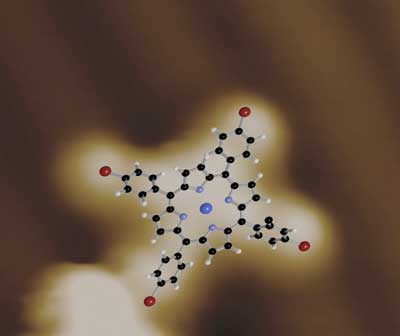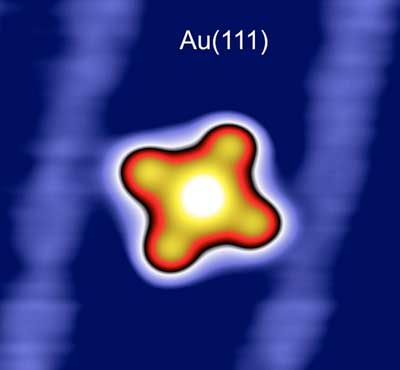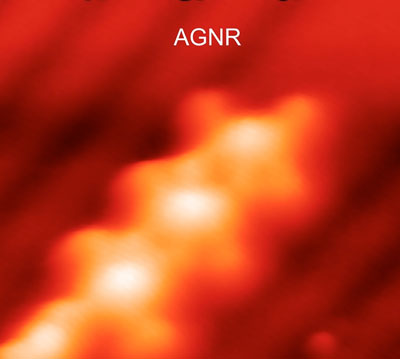| Posted: Feb 23, 2018 |
Opening windows for new spintronic studies
(Nanowerk News) A surprising discovery about spin-electron interactions in a specialized semiconductor material — a “sandwich" of layers with different properties, buffered by a graphene nanoribbon — could potentially offer major advantages in speed, heat dissipation and power consumption in electronic devices (Nature Communications, "Anomalous Kondo Resonance Mediated by Semiconducting Graphene Nanoribbons in a Molecular Heterostructure").
|
 |
| This shows a three-layered device with the magnetic molecule bridging widely spaced “armchair” graphene nanoribbons and its center positioned above — but not touching — the gold surface. The image was taken on a low-temperature scanning tunneling microscopy tool at Argonne’s Center for Nanoscale Materials. (Image: Argonne National Laboratory)
|
|
Graphene nanoribbons are razor-thin, one-dimensional graphene strips — measuring just one atom thick and no more than 50 nanometers wide — that nanoscientists can create on surfaces. For this study, a research team at the U.S. Department of Energy’s (DOE) Argonne National Laboratory built these graphene nanoribbons — specifically, the atomically precise armchair-edge graphene nanoribbons (AGNRs) — on a gold surface.
|
|
This is important because AGNRs become semiconductors at certain widths. The discovery creates new research paths in spintronics, with potential applications in electronic and single-molecule sensing.
|
|
The goal was to use AGNRs to block magnetic interactions on a metal. The team focused on how the AGNRs affect these interactions in a molecule tightly adhered to gold using the phenomenon of Kondo resonance — a well-defined, temperature-dependent effect between a single magnetic atom or molecule and a metal’s free electrons.
|
 |
| The nanoribbons did not block but facilitated interactions between the magnetic molecules and gold crystal surface, shown here in the foreground. The image was taken on a low-temperature scanning tunneling microscopy tool at Argonne’s Center for Nanoscale Materials. (Image: Argonne National Laboratory)
|
|
To do this, the team relied on a low-temperature scanning tunneling microscopy tool at Argonne’s Center for Nanoscale Materials, a DOE Office of Science User Facility.
|
|
The researchers produced two samples with a magnetic molecule known to have strong Kondo effects. One sample contained an AGNR layer and the other did not. The team mapped the tunneling voltage changes and the proportional Kondo temperatures across a nanoscale landscape on both magnetic molecules. The Kondo temperatures indirectly indicate the strength of the spin-electron interactions between the gold and the magnetic molecule.
|
|
The surprise? Instead of blocking the spin interactions between the magnetic molecule and the base metal, the AGNRs actually mediated the spin exchange, resulting in a Kondo effect nearly as strong as in the material lacking AGNRs.
|
 |
| This shows a strand of magnetic molecules atop a dense bed of “armchair” graphene nanoribbons — which appear as a series of closely spaced strings — grown on a gold crystal surface. The image was taken on a low-temperature scanning tunneling microscopy tool at Argonne’s Center for Nanoscale Materials. (Image: Argonne National Laboratory)
|
|
“Initially we were searching for a different result. The project was designed to decouple both electronic and magnetic — spintronic — effects between the magnetic molecules and the gold crystal surface. We were surprised to find a robust spin coupling while the molecules are electronically decoupled,” said lead researcher Saw-Wai Hla, who has a joint appointment as professor of physics and astronomy at the University of Ohio and at Argonne.
|



